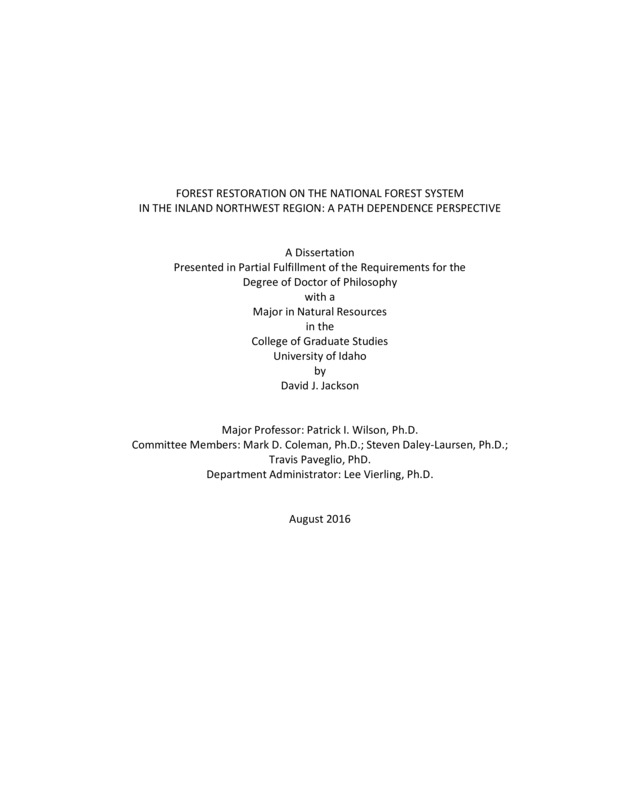Forest Restoration on the National Forest System in the Inland Northwest Region: A Path Dependence Perspective
Jackson, David. (2016). Forest Restoration on the National Forest System in the Inland Northwest Region: A Path Dependence Perspective. Theses and Dissertations Collection, University of Idaho Library Digital Collections. https://www.lib.uidaho.edu/digital/etd/items/jackson_idaho_0089e_10994.html
- Title:
- Forest Restoration on the National Forest System in the Inland Northwest Region: A Path Dependence Perspective
- Author:
- Jackson, David
- Date:
- 2016
- Keywords:
- Forest health Forest restoration National Forest System
- Program:
- Natural Resources
- Subject Category:
- Forestry; Public policy
- Abstract:
-
After more than two centuries of resource management and use, forests in the Inland Northwest region of the United States dependent on fire as a primary natural disturbance have experienced significant changes in structure, functions, and composition. In many areas, alterations to forests’ natural range of variability have created conditions more favorable to wildfire, insects, and disease. Federal policies have been designed to alleviate these concerns, most recently Good Neighbor Authority (GNA) under the 2014 Agricultural Act (Public Law 113-79).
Immediately following passage of the Agricultural Act, 19 million hectare of national forest land were approved for restoration by the USDA Forest Service. However, fire suppression costs, which account for more than 50 percent of the agencies’ budget, have limited funding for restoration, leaving unresolved many social, economic, and environmental questions. Path dependence, a theoretical concept that reveals how events from the past which transpire over long time periods can influence conditions in the present, is well-suited for contextualizing this problem.
Grounded in the path dependence literature, this dissertation evaluated the feasibility of GNA to improve forest health on national forest lands in the Inland Northwest region. Dissertation findings were derived from semi-structured interviews with natural resource management professionals and a web-based survey of engaged public stakeholders. If GNA is to increase the pace and scale of forest restoration on the NFS, natural resource management professionals said more emphasis must be placed on reliable funding, active forest management, and trust between the public and the Forest Service. Potential to mitigate wildfire hazards, improve forest health, and reduce forest restoration costs were regarded by engaged stakeholders as GNA’s most promising benefits. Results from this mixed methods study provide a fuller understanding of the influence policy decisions made at an earlier point in time can have on forest ecosystems in the future.
- Description:
- doctoral, Ph.D., Natural Resources -- University of Idaho - College of Graduate Studies, 2016
- Major Professor:
- Wilson, Patrick
- Committee:
- Coleman, Mark; Daley-Laursen, Steven; Paveglio, Travis
- Defense Date:
- 2016
- Identifier:
- Jackson_idaho_0089E_10994
- Type:
- Text
- Format Original:
- Format:
- application/pdf
- Rights:
- In Copyright - Educational Use Permitted. For more information, please contact University of Idaho Library Special Collections and Archives Department at libspec@uidaho.edu.
- Standardized Rights:
- http://rightsstatements.org/vocab/InC-EDU/1.0/

